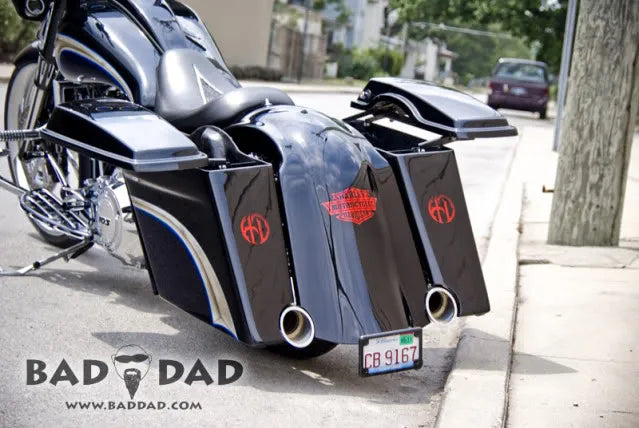These instructions outline installing one of Bad Dad's Custom Flush Mount Fenders over the top of your stock fender. This application does require modifying the stock fender to make room for the custom taillight housings. The details for this are outlined below. These instructions are written for a 2009-current Touring model but the general outline is applicable to all similar Bad Dad products. Keep in mind that most flush mount fenders have custom taillights and Bad Dad has built these specifically per your order. Some variance may exist in each fender due to your order specifications, but these instructions should apply for most applications.
1) This is the back of the stock motorcycle.


2) Begin by removing the stock saddlebags, rear taillight and license plate mount, and the chrome strut covers.


3) Remove the seat.


4) You will need access to the front bolt that secures the fender inside the frame. You will be able to access to this front bolt by moving the front saddlebag pin bracket. Loosen the front saddlebag pin bracket and then flip it upside-down.


5) With the front pin out of the way, remove the front fender bolt.

6) Then remove the upper bolt securing the saddlebag rails to the frame.

7) Now remove the rear fender bolt.

8) And completely remove the fender from the motorcycle.


9) You will now cut the stock fender to make room for the custom taillight. Here are your cutting points: For 1997-2008 Touring models, measure 6" past the rear seat bolt hole. For 2009-current models, measure 9" past the rear seat bolt hole. For Softail models, measure 10" past the rear seat bolt hole. For Yamaha Road Stars, measure 9" past the rear seat bolt hole. Note: Failure to cut at the correct points will place undue pressure on your lower bumper bracket and eventually cause the bumper bracket to break. Please measure correctly.

10) With the fender properly measured and marked, you may now cut off the bottom portion of the fender. Safety glasses are recommended.


11) After the stock rear fender has been cut you may wish to lightly sand the edges of the modified steel fender to keep from cutting yourself in the future. Bad Dad always sands these edges but it is not required.

12) Bad Dad also placed a rubber seal around the edge of the stock fender to prevent the raw edge from damaging the taillight's wiring harness. Again, this is not required but it is recommended.


13) Reinstall the stock fender.


14) Install the front fender bolts.

15) All of Bad Dad's fenders with custom lighting feature a stud installed on the bottom of the rear fender. This stud will pass through the tab on your rear bumper bracket. Note: This stud and tab are for alignment purposes only. Do not overtighten this stud. Overtightening may result in the stud pulling out of the fender. Tighten the stud until the nut is snug and then stop.
16) Slide the Flush Mount Fender over the stock fender by inserting the stud into the tab of the bumper bracket.

17) Fender Installation in progress. Re-install the two wire loom studs and nuts underneath the seat that are located behind the battery box.


18) Next, prepare for the installation of Bad Dad's plug-n-play wiring harness. The main taillight wiring connector for the 2009-current models can be found behind the left-side side cover.

19) The load equalizer and saddlebag quick disconnects are each removable from the main harness.

20) Run the plug-n-play wiring harness underneath the custom fender and on top of the Fender Eliminator. Bad Dad suggests letting the harness rest in the channel between the frame rail and the stock fender. Clip the harness into the stock harness and make the appropriate harness connections underneath the seat.


21) Then secure the ground wire from the wiring harness to the negative terminal of the battery. It is critical that the harness is connected to the negative side of the battery in order to ensure proper grounding for reliable taillight functions.

22) Finally, finish the install by securing the rear seat bolt from the two-up seat.



